It has been a while, so grab a drink and a comfy chair. I'll try to keep this interesting (not, as I told someone recently, "and then they did this, and then I did that, after which they did this, causing me to decide to do the other...") because it has been another interesting and challenging year. Yet, things are changing— including how I'm handling the honeybees — and it is by turns mind-opening and a bit frightening to see what stays and what goes as we travel along this life together. But there is not much poetry in playing catch-up here, and I promise to do better later.
If there is a way to make this a short story, it is in the title of this post: last year ended with 5 hives, and 2007 started with only 4, when the mill hive died. For one reason or another (winning a package of bees at the club holiday party, deciding it made no sense to keep just one hive at the historic mill) by the end of April I had 7 hives in three locations. The monastery hives had trouble, though, and I had to fight to keep them alive, ending up uniting one of the struggling hives with the bodacious packaged bees (who just took off like crazy! Rock on girls!). So that makes six hives, all buzzing along quite nicely now, with almost no thanks due to me. It's a bit overwhelming, and I have been forced to take up a different kind of relationship with the bees: less "personal" if you will, but more respectful of them.
Excuses, Excuses
 I have a lot to tell you even so, and therefore there are lots of small pictures on the left: if you click them they will pop up to the larger shots you might be used to here. This first one shows you one thing that has taken up alot of the past two months: assembling woodenware. The stuff at left is just the last batch of over 10 boxes (and associated frames) that joined our inventory this year. In previous years, I bought completely assembled hive parts, paying the extra money and banking the time. However, last year I read an article that said honeybees do better when given pure beeswax frames, and you can't get those shipped to you. Also, I felt a bit like a fraudulent beekeeping mentor when newbees ask me how to put their hives together, and I have been basically clueless.
I have a lot to tell you even so, and therefore there are lots of small pictures on the left: if you click them they will pop up to the larger shots you might be used to here. This first one shows you one thing that has taken up alot of the past two months: assembling woodenware. The stuff at left is just the last batch of over 10 boxes (and associated frames) that joined our inventory this year. In previous years, I bought completely assembled hive parts, paying the extra money and banking the time. However, last year I read an article that said honeybees do better when given pure beeswax frames, and you can't get those shipped to you. Also, I felt a bit like a fraudulent beekeeping mentor when newbees ask me how to put their hives together, and I have been basically clueless.
 Which brings me to my next great excuse for prolonged absence: I've been out trying to give what guidance I can to even newer beekeepers! The picture at left is my friend Jane in her apiary. I've been out there a couple of times (mostly because she worries too much!) and she has helped out at the mill, too. But I have also helped two new beekeepers set up at the Monastery (Joe and Joseph, with 2 and one hives respectively) and had a look into the hives of Bill, Andrea, and Jill. Mostly, new beekeepers just need a more experienced set of eyes to say "that's drone brood" or "this is a 3-day old egg) or "there's your queen" while they educate their own visual databanks. Sometimes there is an issue (like a crowded brood chamber) so I show them a few easy steps to sort things out. It's the kind of help I needed and got, and it is my duty to get out there myself.
Which brings me to my next great excuse for prolonged absence: I've been out trying to give what guidance I can to even newer beekeepers! The picture at left is my friend Jane in her apiary. I've been out there a couple of times (mostly because she worries too much!) and she has helped out at the mill, too. But I have also helped two new beekeepers set up at the Monastery (Joe and Joseph, with 2 and one hives respectively) and had a look into the hives of Bill, Andrea, and Jill. Mostly, new beekeepers just need a more experienced set of eyes to say "that's drone brood" or "this is a 3-day old egg) or "there's your queen" while they educate their own visual databanks. Sometimes there is an issue (like a crowded brood chamber) so I show them a few easy steps to sort things out. It's the kind of help I needed and got, and it is my duty to get out there myself.
 Excuse number three boils down to even more doings in the world of humans, rather than bees, though it is the girls' fault to some extent. This picture shows my non-beekeeper cousin holding a frame of monastery bees (note this people: NO GLOVES!) We were on the road together for a week, celebrating her completion of another year of college on her way to becoming the teacher we all wish we had. She also helped me out with a surprisingly stressful commitment to volunteer in three different capacities (am I a moron, or what?) at the bicentennial of a historic site where I walk my dogs. This is the same place where we had the yellowjacket adventure last year, so the bees are really responsible for my rise to prominence (and exhaustion :-) ) over there.
Excuse number three boils down to even more doings in the world of humans, rather than bees, though it is the girls' fault to some extent. This picture shows my non-beekeeper cousin holding a frame of monastery bees (note this people: NO GLOVES!) We were on the road together for a week, celebrating her completion of another year of college on her way to becoming the teacher we all wish we had. She also helped me out with a surprisingly stressful commitment to volunteer in three different capacities (am I a moron, or what?) at the bicentennial of a historic site where I walk my dogs. This is the same place where we had the yellowjacket adventure last year, so the bees are really responsible for my rise to prominence (and exhaustion :-) ) over there.
 Which brings me to the last figleaf of this post, but it is one to which you new beekeepers might want to pay attention: if you start looking out for bees and flowers, you are not very far off from butterflies and bats, and maybe snapping turtles and birds and ladybugs. Just after I began keeping honeybees, the world suddenly seemed to contain astoundingly more flowers and smells. This year, the yard seems to contain a remarkable selection of butterflies, birds, and native plants (which might have been simple weeds just a couple of years ago). When you open a door in your life, it's amazing the company you start to keep.
Which brings me to the last figleaf of this post, but it is one to which you new beekeepers might want to pay attention: if you start looking out for bees and flowers, you are not very far off from butterflies and bats, and maybe snapping turtles and birds and ladybugs. Just after I began keeping honeybees, the world suddenly seemed to contain astoundingly more flowers and smells. This year, the yard seems to contain a remarkable selection of butterflies, birds, and native plants (which might have been simple weeds just a couple of years ago). When you open a door in your life, it's amazing the company you start to keep.
The Roof Bees
 But you are probably more interested in bees than excuses, so perhaps you would like to know what is happening up on the roof. After losing the mill bees to mite-borne illness (or so I think today: ask me again in a few months...) I decided to get serious about Spring varroa mite treatment. Around here, the weather does not cooperate with the methods I like the best: I won't use the neurotoxin pesticides, and the essential oil and formic acid treatments have exacting temperature requirements. The roof bees were most similar to the colony that died in terms of persistent mite loads and the type of treatment they received last year, so I was VERY worried. I did not want to use oxalic acid again, and the confectioner's sugar treatment (more on that below) would result in a layer of frosting on my roof.
But you are probably more interested in bees than excuses, so perhaps you would like to know what is happening up on the roof. After losing the mill bees to mite-borne illness (or so I think today: ask me again in a few months...) I decided to get serious about Spring varroa mite treatment. Around here, the weather does not cooperate with the methods I like the best: I won't use the neurotoxin pesticides, and the essential oil and formic acid treatments have exacting temperature requirements. The roof bees were most similar to the colony that died in terms of persistent mite loads and the type of treatment they received last year, so I was VERY worried. I did not want to use oxalic acid again, and the confectioner's sugar treatment (more on that below) would result in a layer of frosting on my roof.
 My solution was this: formic acid pads —"Mite Away II," in fact. As treatments go, it is pretty convenient and non-toxic. The temperature has to stay above 50 degrees F, and below 79 degrees F (at least during the first week), though. Around here, Spring is a bumpy time, and nights in the 50s quickly turn into days in the 80s. The pads have to be on for 21 days, and you have to get them out of there before the honey flow (in other words, May) so you can see that timing is everything. The heavy dose of formic acid which is release in the first week also hurts uncapped brood, which can put a hole in the workforce just before the honey flow here. The pads went on April 26 and came off on May 17. I've never tried a Spring mite treatment before, and truly hope this will make a major contribution to the health of the girls this season. They need every break they can get.
My solution was this: formic acid pads —"Mite Away II," in fact. As treatments go, it is pretty convenient and non-toxic. The temperature has to stay above 50 degrees F, and below 79 degrees F (at least during the first week), though. Around here, Spring is a bumpy time, and nights in the 50s quickly turn into days in the 80s. The pads have to be on for 21 days, and you have to get them out of there before the honey flow (in other words, May) so you can see that timing is everything. The heavy dose of formic acid which is release in the first week also hurts uncapped brood, which can put a hole in the workforce just before the honey flow here. The pads went on April 26 and came off on May 17. I've never tried a Spring mite treatment before, and truly hope this will make a major contribution to the health of the girls this season. They need every break they can get.
 With apologies for the smear on the lens, here is the latest rooftop plot twist. These are supercedure cells in Wilde, my crazy Carniolan tribe. There were also THREE capped queen cells in the swarm position at the same time. We found them just as my cousin and I had to leave for our trip, so the next morning in the car, I sat there wondering whether they had left, and whether the formic acid treatment gave them a better chance of surviving if they did set up shop on their own. MaryEllen told me that the swarming impulse was considerably muted during the honeyflow, so maybe they would not go at all. As of today, it appears that they did not go. Perhaps they superceded, though their mom (a supercedure queen herself) is doing a great job.
With apologies for the smear on the lens, here is the latest rooftop plot twist. These are supercedure cells in Wilde, my crazy Carniolan tribe. There were also THREE capped queen cells in the swarm position at the same time. We found them just as my cousin and I had to leave for our trip, so the next morning in the car, I sat there wondering whether they had left, and whether the formic acid treatment gave them a better chance of surviving if they did set up shop on their own. MaryEllen told me that the swarming impulse was considerably muted during the honeyflow, so maybe they would not go at all. As of today, it appears that they did not go. Perhaps they superceded, though their mom (a supercedure queen herself) is doing a great job.
The workers may have blamed her for the brood break that came with the formic, or they may have called it all off later. I am not sure, but I can tell you that there are three medium supers of honey on that colony, and probably 60,000 bees, so it is nonetheless a good year so far.
But what about Twain, you might ask? That hive superceded last year, too, and is still standing. The colony has fewer bees and less honey than Wilde, but it is definitely happy and strong. I was just in there today, giving another honey super to them. Even though most beekeepers here think that the main nectar flow is over, we have lots of linden trees planted along the streets, bursting with blooms. I hope that they will continue collecting actively for at least another week. While in the hive, I saw the darkest honey ever: tulip poplar, probably. There was no evidence of swarm cells, and lots of new eggs. While not as dramatic as the Carnies, Twain's Italian honeybees are buzzing along just fine.
The Monastery Bees
 The Franciscan bees have presented the biggest scare and largest challenge of the year, so far. Sometime in late Winter, both queens became drone layers, and I had to pull all sorts of drone brood and requeen. Unfortunately, the Minnesota Hygienic queens that were available so early turned out to have problems. MaryEllen had several, none of which worked out, and one of mine ended up dying at my hand.
The Franciscan bees have presented the biggest scare and largest challenge of the year, so far. Sometime in late Winter, both queens became drone layers, and I had to pull all sorts of drone brood and requeen. Unfortunately, the Minnesota Hygienic queens that were available so early turned out to have problems. MaryEllen had several, none of which worked out, and one of mine ended up dying at my hand.
When the package bees I won arrived, I installed them in a nuc box at the Monastery as well. You can see the box at the left, with another upside down nuc box on top (to function as a feeder box). Those bees took off at once, with the queen laying wall-to-wall and happy bees flying to and fro all day long.
 For several weeks, I went to the Monastery to monitor how the Minnesota queens were doing, from being released through initial laying. The queen in the Doug colony (furthest right in all of these pictures) came online relatively well, but the MaryEllen-the-Hive queen produced just a very few brood cells, then would stop, then would start, and I could never find eggs. For a month, I would go every few days, planning that "today is the day" I would kill the weak queen and unite the remaining bees with the nuc. You can see from this picture that the package had grown so big that they had been expanded into a full hive body.
For several weeks, I went to the Monastery to monitor how the Minnesota queens were doing, from being released through initial laying. The queen in the Doug colony (furthest right in all of these pictures) came online relatively well, but the MaryEllen-the-Hive queen produced just a very few brood cells, then would stop, then would start, and I could never find eggs. For a month, I would go every few days, planning that "today is the day" I would kill the weak queen and unite the remaining bees with the nuc. You can see from this picture that the package had grown so big that they had been expanded into a full hive body.  Then, in the next picture, you can see that they actually grew larger than MaryEllen-the-Hive.
Then, in the next picture, you can see that they actually grew larger than MaryEllen-the-Hive.
Finally, I opened up the colony, and found that wax moths had started to breed, and that the bees had been too weak to fight them off. The time had come, as much as I hated to kill a poor, innocent creature who had earned no blame. To let her live, all her children would die, and a hive that could give life to thousands of wild plants (and the creatures that depend on them) would cease to exist. It was my responsibility, and I did it, but I wish she had not seemed so terrified and confused. It was not her fault.
 But let me try to explain what I saw. Here's a shot of a really great brood pattern. Do you see how there are very few open cells? The edges of the frame hold nectar and pollen for the nurse bees to use in taking care of the brood. The queen began laying in the center of this frame, and little by little, cell by cell, spiraled outward, laying. The cells in the middle will hatch first: some of the empties near the edges may actually be brood that has not been capped yet. The queen will come back later and lay again in these cells, once they are cleaned and ready to go again.
But let me try to explain what I saw. Here's a shot of a really great brood pattern. Do you see how there are very few open cells? The edges of the frame hold nectar and pollen for the nurse bees to use in taking care of the brood. The queen began laying in the center of this frame, and little by little, cell by cell, spiraled outward, laying. The cells in the middle will hatch first: some of the empties near the edges may actually be brood that has not been capped yet. The queen will come back later and lay again in these cells, once they are cleaned and ready to go again.
 This is a not-so-great pattern. If you click on this picture, you will get a bigger-than-normal photo, an attempt to show you something which is a little hard to see. This is a medium frame, but it is not even filled out top-to-bottom. There are more empties than filled holes. Finally, do you see the queen cups on the bottom? These workers know that they need a new mom, and are trying to get one. The cups are actually in a swarm position, but the hive is so low on population that there is no way they will swarm. I think they are just trying to get a new queen any way they can, and they are not succeeding.
This is a not-so-great pattern. If you click on this picture, you will get a bigger-than-normal photo, an attempt to show you something which is a little hard to see. This is a medium frame, but it is not even filled out top-to-bottom. There are more empties than filled holes. Finally, do you see the queen cups on the bottom? These workers know that they need a new mom, and are trying to get one. The cups are actually in a swarm position, but the hive is so low on population that there is no way they will swarm. I think they are just trying to get a new queen any way they can, and they are not succeeding.
So in early May I united the nuc and MaryEllen-the-Hive, and they seem to be doing really well now. I still need to watch Doug, because that hive still has a hygienic queen, the last among all the queens that MaryEllen and I installed from that shipment that still appears to be reigning over a hive. Therefore, there is reason to worry that she will peter out. But so far, so good.
You might wonder why I am not talking about varroa treatments at the Monastery, and you would be a smartie if you did. The reason that I did not do a Spring treatment is this: the drone laying and drone larvae removal was one massive IPM-style varroa treatment. The mites are attracted to drone larvae preferentially, and when you remove the boys, you generally whallop the varroa population. Also, requeening caused a big disruption in the hives' brood cycles, also depressing the varroa population. Therefore, I am holding off until Fall, trying not to interfere too much in these very messed-with hives.
The Historic Mill Bees
 In a way, I've saved the simplest, most rewarding story for last. Here is the Mill apiary, with 4 hives and a nuc (the small colony with a red strap around it). MaryEllen-the-Beekeeper is having her swarmiest year ever, so she keeps having to stash a nuc of captured wanderers at the Mill while she plans her next move. Since last year, a big old tree that overshadowed the apiary had to be removed (or it would fall down) and you can see me in the background in front of our new privacy fence. The extra sunlight seems to have done wonders for the girls, because we are all doing really well so far.
In a way, I've saved the simplest, most rewarding story for last. Here is the Mill apiary, with 4 hives and a nuc (the small colony with a red strap around it). MaryEllen-the-Beekeeper is having her swarmiest year ever, so she keeps having to stash a nuc of captured wanderers at the Mill while she plans her next move. Since last year, a big old tree that overshadowed the apiary had to be removed (or it would fall down) and you can see me in the background in front of our new privacy fence. The extra sunlight seems to have done wonders for the girls, because we are all doing really well so far.
 Here are my two colonies. I am trying to replace all the green boxes with white to get away from the stripey look and to keep better track of my gear inventory, but you see how it is. These two big colonies were actually started from packages just two months ago, and they took off like a rocket. The packages were installed onto comb that the girls who died left behind, somethig that worried me. But there is no evidence of disease so far, and a general vibe of health and happiness seems to spread from those boxes. There were three medium supers of not-yet-capped honey on each hive when I visited a couple of days ago, really wonderful for colonies started from packages this year!
Here are my two colonies. I am trying to replace all the green boxes with white to get away from the stripey look and to keep better track of my gear inventory, but you see how it is. These two big colonies were actually started from packages just two months ago, and they took off like a rocket. The packages were installed onto comb that the girls who died left behind, somethig that worried me. But there is no evidence of disease so far, and a general vibe of health and happiness seems to spread from those boxes. There were three medium supers of not-yet-capped honey on each hive when I visited a couple of days ago, really wonderful for colonies started from packages this year!
 This is just a gratuitous art shot of bees through the inner cover on the day I replaced it with a screened cover (for better ventilation and heat reduction). I just love to look at them.
This is just a gratuitous art shot of bees through the inner cover on the day I replaced it with a screened cover (for better ventilation and heat reduction). I just love to look at them.
 And also a bit unnecessarily, here is a picture of some mill nurse bees taking care of new eggs. It is more important to see eggs than to track down the queen, and these hives have made it very easy for me this year. They have grown fabulously and happily, and I just hope to stay ahead of them in meeting their needs, including varroa management. The mites killed their predecessors, and I want to do better this year.
And also a bit unnecessarily, here is a picture of some mill nurse bees taking care of new eggs. It is more important to see eggs than to track down the queen, and these hives have made it very easy for me this year. They have grown fabulously and happily, and I just hope to stay ahead of them in meeting their needs, including varroa management. The mites killed their predecessors, and I want to do better this year.
 After going to a state beekeeping meeting where the role of all kinds of chemicals was a concern in the recent Colony Collapse Disorder crisis, I became convinced that I should try a completely non-toxic, non-chemical approach to control at the Mill. Here you see two cups of confectioners' sugar ladled onto the screened top of a hive.
After going to a state beekeeping meeting where the role of all kinds of chemicals was a concern in the recent Colony Collapse Disorder crisis, I became convinced that I should try a completely non-toxic, non-chemical approach to control at the Mill. Here you see two cups of confectioners' sugar ladled onto the screened top of a hive.
 By brushing the powdered sugar into the hive, I can cause the varroa mites to lose their footing and fall off the bees. The powdered sugar literally clogs up the little hooks and hairs they use to grab bees, and the motes fall down to the waiting ants. The bees can actually eat any extra sugar, and the grooming behavior they use to remove it also helps in mite control.
By brushing the powdered sugar into the hive, I can cause the varroa mites to lose their footing and fall off the bees. The powdered sugar literally clogs up the little hooks and hairs they use to grab bees, and the motes fall down to the waiting ants. The bees can actually eat any extra sugar, and the grooming behavior they use to remove it also helps in mite control.
 The only problem with this treatment is that it needs to be repeated regularly and many many times besides. I know a beekeeper who used this treatment exclusively, and nonetheless lost her bees. Therefore, I need to watch for any signs of an infestation, and have another plan just in case one erupts. I have formic pads set aside as a fall treatment even now, but my jury is out on what to do if an infestation erupts during hot weather.
The only problem with this treatment is that it needs to be repeated regularly and many many times besides. I know a beekeeper who used this treatment exclusively, and nonetheless lost her bees. Therefore, I need to watch for any signs of an infestation, and have another plan just in case one erupts. I have formic pads set aside as a fall treatment even now, but my jury is out on what to do if an infestation erupts during hot weather.

 It can actually be a little entertaining to apply this treatment. The bees change their buzz as soon as you drop the sugar, and they begin flying around in a somewhat disoriented fashion, looking like little ghost bees. Here's a whitened bee lifting her nasanoff gland, followed by another grooming herself on a fencepost. Notice the little white spot she left when she landed!
It can actually be a little entertaining to apply this treatment. The bees change their buzz as soon as you drop the sugar, and they begin flying around in a somewhat disoriented fashion, looking like little ghost bees. Here's a whitened bee lifting her nasanoff gland, followed by another grooming herself on a fencepost. Notice the little white spot she left when she landed!

 The bees probably do not see so well with sugar in their eyes, and in the left picture you can see a bee that drifted into the hive next door during the mere 10 minutes between when I opened the first one and then the second to apply the treatment. The right picture shows a hapless bee that has been captured by a "Daring Jumping Spider," kind of a cool looking beastie itself. I know this may sound odd or wrong to you, but I am actually glad to see the bees become a part of ALL portions of the cycle of life where they are located. Honeybees are not native to North America, but if they can slip into an integrated role in a balanced ecology, they can provide tremendous benefit. I am sorry to kill bees, but not sorry to see life be succeeded by death and renewed life in the natural order of things.
The bees probably do not see so well with sugar in their eyes, and in the left picture you can see a bee that drifted into the hive next door during the mere 10 minutes between when I opened the first one and then the second to apply the treatment. The right picture shows a hapless bee that has been captured by a "Daring Jumping Spider," kind of a cool looking beastie itself. I know this may sound odd or wrong to you, but I am actually glad to see the bees become a part of ALL portions of the cycle of life where they are located. Honeybees are not native to North America, but if they can slip into an integrated role in a balanced ecology, they can provide tremendous benefit. I am sorry to kill bees, but not sorry to see life be succeeded by death and renewed life in the natural order of things.
 Finally, while there I actually saw one of the Mill queens cruising around, measuring a cell, and laying an egg. Unfortunately, I smeared my lens again, so this is the best I could do. It was a treat to see an utterly unbothered queen, healthily going about her regal business, supporting a family that is doing well.
Finally, while there I actually saw one of the Mill queens cruising around, measuring a cell, and laying an egg. Unfortunately, I smeared my lens again, so this is the best I could do. It was a treat to see an utterly unbothered queen, healthily going about her regal business, supporting a family that is doing well.
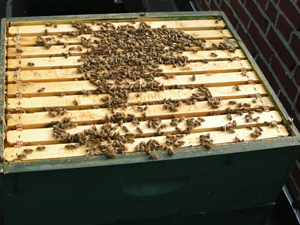 My Romanian beekeeper friend George Tamas (his blog is linked at right, "Happy Apiary") once told me about the benefits of knocking on beehives. Most of you might question the sanity of walking up to a perfectly peaceful hive of honeybees, rapping smartly on the side, and then pressing your cheek tight up against it to hear what you can hear.
My Romanian beekeeper friend George Tamas (his blog is linked at right, "Happy Apiary") once told me about the benefits of knocking on beehives. Most of you might question the sanity of walking up to a perfectly peaceful hive of honeybees, rapping smartly on the side, and then pressing your cheek tight up against it to hear what you can hear. 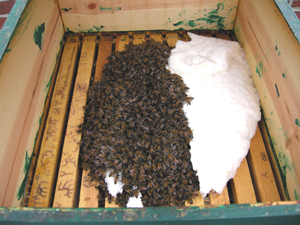 When I put them to bed in the autumn, all my bees were in the bottom box of the stack, and I had placed supers full of honey above them. Because I am the worrying kind, I also put additional food above that. This is a picture of the Wilde bees chewing on some fondant I had put on earlier.
When I put them to bed in the autumn, all my bees were in the bottom box of the stack, and I had placed supers full of honey above them. Because I am the worrying kind, I also put additional food above that. This is a picture of the Wilde bees chewing on some fondant I had put on earlier. 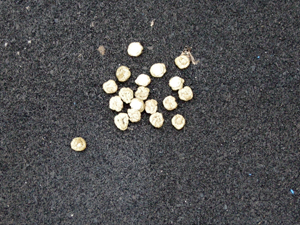 The Wilde hive had been worrying me for a while. There wasn't as much action out the front door as I like, and my knocking seemed to indicate very few bees in any one box, with the majority, perhaps, very high up! I did not see alot of dead bees around, but the presence of some concentrated crow poop meant that the birds may have finally taken to cleaning up departed buzzers, and I could have dying bees without a lot of visual clues.
The Wilde hive had been worrying me for a while. There wasn't as much action out the front door as I like, and my knocking seemed to indicate very few bees in any one box, with the majority, perhaps, very high up! I did not see alot of dead bees around, but the presence of some concentrated crow poop meant that the birds may have finally taken to cleaning up departed buzzers, and I could have dying bees without a lot of visual clues.

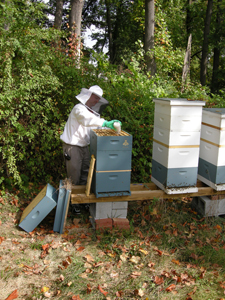 Perhaps you know this already, but the brothers at the Monastery were kind enough to welcome three beekeepers this year: me, Joe (the president of the Monastery Garden Guild), and Joseph (a hapless dogwalker I snagged with bee tales last year). Both Joe and Joseph have been my "mentees" this year (a.k.a. I am their beekeeping mentor), but I have not been on top of them about their mite treatments.
Perhaps you know this already, but the brothers at the Monastery were kind enough to welcome three beekeepers this year: me, Joe (the president of the Monastery Garden Guild), and Joseph (a hapless dogwalker I snagged with bee tales last year). Both Joe and Joseph have been my "mentees" this year (a.k.a. I am their beekeeping mentor), but I have not been on top of them about their mite treatments.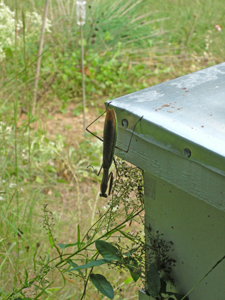 OK, looking at this image, what is the reaction you expect? Horror? outrage? Morbid curiousity? Would you be terribly disillusioned if what I told you instead was "How cool is that?!"
OK, looking at this image, what is the reaction you expect? Horror? outrage? Morbid curiousity? Would you be terribly disillusioned if what I told you instead was "How cool is that?!"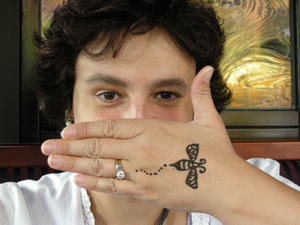 Every August, we seem to hit the road. For a beekeeper around here, this is a wise thing to do. The flowers are dried up, the bees are bored and a bit defensive, and it is time just to load up those hive top feeders with sugar syrup, squish as few of the teeming girls as I can, and head off to other buzzing bits of the world.
Every August, we seem to hit the road. For a beekeeper around here, this is a wise thing to do. The flowers are dried up, the bees are bored and a bit defensive, and it is time just to load up those hive top feeders with sugar syrup, squish as few of the teeming girls as I can, and head off to other buzzing bits of the world.  And so off we went. We usually hop a plane and go someplace expensive and exciting, but this year we figured out that there was a 600 mile stretch heading north that neither of us had every really explored, and so we went on a road trip. This also needs to be said: my cousin and I had an excellent road trip in May, so my husband seemed to want a bigger, better one for the two of us (everybody should be smiling at this, ok?)
And so off we went. We usually hop a plane and go someplace expensive and exciting, but this year we figured out that there was a 600 mile stretch heading north that neither of us had every really explored, and so we went on a road trip. This also needs to be said: my cousin and I had an excellent road trip in May, so my husband seemed to want a bigger, better one for the two of us (everybody should be smiling at this, ok?) 
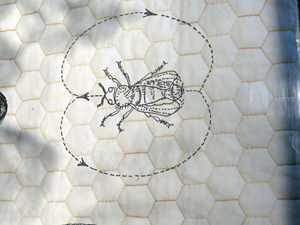 Now, I have had a hard time keeping up with this blog, partly because I have so much to tell you. For instance, the first picture up there is a henna tattoo from the Byward Market in Ottawa, where the nice young man had to be asked to include a thorax on his bee, and this last picture is from an impossible-to-describe glass bee artwork by Michael Rogers at the Corning Museum of Glass in New York. But let this be enough for now: there will be more.
Now, I have had a hard time keeping up with this blog, partly because I have so much to tell you. For instance, the first picture up there is a henna tattoo from the Byward Market in Ottawa, where the nice young man had to be asked to include a thorax on his bee, and this last picture is from an impossible-to-describe glass bee artwork by Michael Rogers at the Corning Museum of Glass in New York. But let this be enough for now: there will be more.
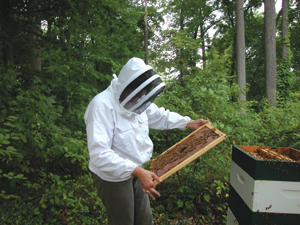 This is a geeky hive-management report, the kind of post that I cannot imagine someone else reading. Since it is also the sort of thing that has been preoccupying me lately, and you have not heard much (sorry), well, here goes. You know, I would welcome your feedback on this kind of subject matter, either in comments (below) or emails to me (phang@tonitoni.org). Questions are also welcome!
This is a geeky hive-management report, the kind of post that I cannot imagine someone else reading. Since it is also the sort of thing that has been preoccupying me lately, and you have not heard much (sorry), well, here goes. You know, I would welcome your feedback on this kind of subject matter, either in comments (below) or emails to me (phang@tonitoni.org). Questions are also welcome!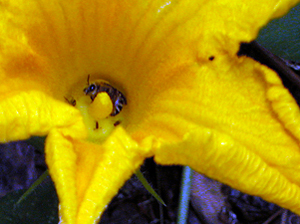 Every flower is an invitation, people. Perfectly respectable plants swallow up a bunch of energy, generate a bud and a bloom, and then bang out an explosion of color and scent and pollen and nectar. There has to be an important reason to go to this much effort, to divert this many resources from the business of photosynthesizing and growing, and wouldn't you just know that it has to be sex?
Every flower is an invitation, people. Perfectly respectable plants swallow up a bunch of energy, generate a bud and a bloom, and then bang out an explosion of color and scent and pollen and nectar. There has to be an important reason to go to this much effort, to divert this many resources from the business of photosynthesizing and growing, and wouldn't you just know that it has to be sex?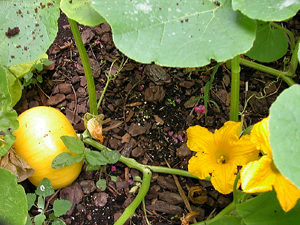 I'm being bombastic here, but it's caused by just a bit of (non- reproductive) frustration. With the impact that Colony Collapse Disorder (CCD) has had on the news in this country, and the opportunity it has given to truly show people the most important part of the honeybee-human relationship, I'm still having trouble explaining pollination to kids. It's basically the way in which plants get the male bit (pollen on the stamens) over to the female bit (the ovaries in the pistils), hopefully on a different plant. They overproduce the pollen to guarantee coverage and offer a protein food, they produce nectar THEY DON'T EVEN USE down near the bottom to get the dusty bees to go where the action is. This picture shows the act in progress at the right, and the fruit of the deed at the left.
I'm being bombastic here, but it's caused by just a bit of (non- reproductive) frustration. With the impact that Colony Collapse Disorder (CCD) has had on the news in this country, and the opportunity it has given to truly show people the most important part of the honeybee-human relationship, I'm still having trouble explaining pollination to kids. It's basically the way in which plants get the male bit (pollen on the stamens) over to the female bit (the ovaries in the pistils), hopefully on a different plant. They overproduce the pollen to guarantee coverage and offer a protein food, they produce nectar THEY DON'T EVEN USE down near the bottom to get the dusty bees to go where the action is. This picture shows the act in progress at the right, and the fruit of the deed at the left.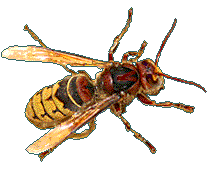 The title here is not the name of an odd law firm or a long-forgotten track by the Rolling Stones, and the bug pictured did not actually sting me...but it all applies to June and July. Welcome to the heart of the hot season around here, with all of the thrills (and very few chills) it brings.
The title here is not the name of an odd law firm or a long-forgotten track by the Rolling Stones, and the bug pictured did not actually sting me...but it all applies to June and July. Welcome to the heart of the hot season around here, with all of the thrills (and very few chills) it brings.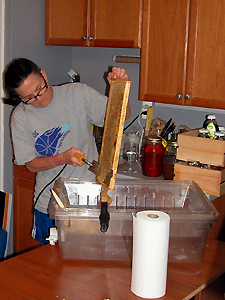 Since the nectar flow ended over a month ago, the harvest season is upon us (you might say it is all over us, too – as well as the floors, the counters and the dogs). That's the sticky part of all this. In late June, MaryEllen and I got together with Jane to help the latter harvest honey for the first time. Some of the usual panic ensued: "How do I get my honey frames out of the hive?!" But Jane worked it out – in this case, by using an approach more common in Europe. You can remove a limited amount of honey by reaching in, grabbing one frame at a time, walking away and shaking the bees off ,then brushing the remainder gently away and stowing the now bee-free frame in a covered box. This is good for only a few frames, because after a bunch of shaking the bees get Quite Unhappy. Jane cleared two boxes, and took home 5 gallons of honey! I pulled only 9 frames from the roof, and was pleased to get a bit more than two gallons of very light honey. I think it's a mostly-linden year!
Since the nectar flow ended over a month ago, the harvest season is upon us (you might say it is all over us, too – as well as the floors, the counters and the dogs). That's the sticky part of all this. In late June, MaryEllen and I got together with Jane to help the latter harvest honey for the first time. Some of the usual panic ensued: "How do I get my honey frames out of the hive?!" But Jane worked it out – in this case, by using an approach more common in Europe. You can remove a limited amount of honey by reaching in, grabbing one frame at a time, walking away and shaking the bees off ,then brushing the remainder gently away and stowing the now bee-free frame in a covered box. This is good for only a few frames, because after a bunch of shaking the bees get Quite Unhappy. Jane cleared two boxes, and took home 5 gallons of honey! I pulled only 9 frames from the roof, and was pleased to get a bit more than two gallons of very light honey. I think it's a mostly-linden year!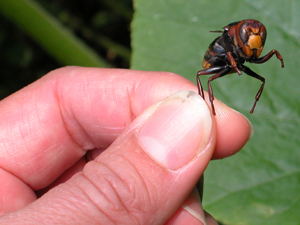 But the "Dead" in today's title refers to an impressive hornet specimen found on the bottom of the Clare hive right after Andrea keeled over and was driven home. Though the hornet is easily twice the size of the worker bees, they nonetheless have a group defense against the interlopers. In this case, the presence of most of a hornet carcass confirms that the hives have been under regular attack, and have been defending themselves vigorously. The hornet is too big for the undertaker bees to move, so they have been chewing pieces off and disposing of them. Her abdomen, wings, and antennae are almost completely gone.
But the "Dead" in today's title refers to an impressive hornet specimen found on the bottom of the Clare hive right after Andrea keeled over and was driven home. Though the hornet is easily twice the size of the worker bees, they nonetheless have a group defense against the interlopers. In this case, the presence of most of a hornet carcass confirms that the hives have been under regular attack, and have been defending themselves vigorously. The hornet is too big for the undertaker bees to move, so they have been chewing pieces off and disposing of them. Her abdomen, wings, and antennae are almost completely gone. 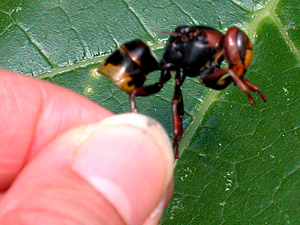 Even though we are thousands of times the size of such a creature, we humans often feel a great thud in the middle of our chests when we confront these beasts. When I was holding the hornet bits to try to get a photo for you, I could hear the distant "Ewwww!" of some frightened multitudes in the back of my mind, but the revulsion must be paired with an unescapable attraction, or why would our Porsches and muscle-car marauders choose to look so much the same?
Even though we are thousands of times the size of such a creature, we humans often feel a great thud in the middle of our chests when we confront these beasts. When I was holding the hornet bits to try to get a photo for you, I could hear the distant "Ewwww!" of some frightened multitudes in the back of my mind, but the revulsion must be paired with an unescapable attraction, or why would our Porsches and muscle-car marauders choose to look so much the same?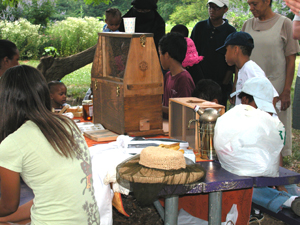 Finally, I want you to know that June 24-30 was the first
Finally, I want you to know that June 24-30 was the first 























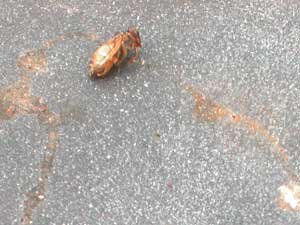 Today I checked my hives after days of hard wind and rain. A honeybee pulled out a young, deformed worker, and dropped her a few yards away. The sick bee moved a little, but had no hope to live. Her sister took no time for pity. I did, but couldn't know whether a short tap from my toe would end her misery or shorten her only moment of sunshine. So it is with bees.
Today I checked my hives after days of hard wind and rain. A honeybee pulled out a young, deformed worker, and dropped her a few yards away. The sick bee moved a little, but had no hope to live. Her sister took no time for pity. I did, but couldn't know whether a short tap from my toe would end her misery or shorten her only moment of sunshine. So it is with bees.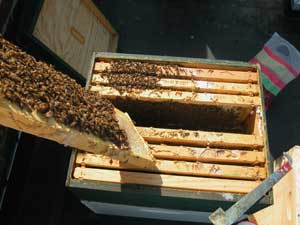 Sorry that it has been a while folks, but as a local apiary inspector told me in a (late) email this week, it's the time of year when beekeepers tend to be digging in beehives, not tickling mice!
Sorry that it has been a while folks, but as a local apiary inspector told me in a (late) email this week, it's the time of year when beekeepers tend to be digging in beehives, not tickling mice!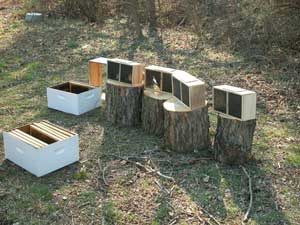 On March 25, we did a simple thing that should not be overrated: we installed 4 packages of bees! Jane (another club member, who worries way too much about how she handles her bees) came along to help and to get more experience. Watch the sidebar for a detailed run-down of how we did it: I messed up a lot less than I did two years ago! My girls went onto drawn comb left by the deceased colony: this should help them get a much quicker start because the queen can begin to lay right away, and there is already honey in the hive for nurses to feed the young. MaryEllen checked a couple of days later, and said it all looked like a living apiary again. I will name one of the hives "Cockrill" again (hey, no superstition here) but am currently stumped for the other hive's name. I'm thinking about perhaps the current miller on the site...
On March 25, we did a simple thing that should not be overrated: we installed 4 packages of bees! Jane (another club member, who worries way too much about how she handles her bees) came along to help and to get more experience. Watch the sidebar for a detailed run-down of how we did it: I messed up a lot less than I did two years ago! My girls went onto drawn comb left by the deceased colony: this should help them get a much quicker start because the queen can begin to lay right away, and there is already honey in the hive for nurses to feed the young. MaryEllen checked a couple of days later, and said it all looked like a living apiary again. I will name one of the hives "Cockrill" again (hey, no superstition here) but am currently stumped for the other hive's name. I'm thinking about perhaps the current miller on the site... We are in Israel, prompted to another adventure by a wedding invitation, and what is any trip without casting an eye about for bees? In this case, Sam found me a beekeeper who runs a visitors' center for busloads of children, with room for straggling adults like us on holidays and Saturdays (www.tour-galilee.co.il). We took a tour (in Hebrew) with a really good guide named Yasmin, and though we struggled to follow, it was absolutely clear that everyone always laughs at the same part of the presentation: the bit about (ahem) limited role of the drone...
We are in Israel, prompted to another adventure by a wedding invitation, and what is any trip without casting an eye about for bees? In this case, Sam found me a beekeeper who runs a visitors' center for busloads of children, with room for straggling adults like us on holidays and Saturdays (www.tour-galilee.co.il). We took a tour (in Hebrew) with a really good guide named Yasmin, and though we struggled to follow, it was absolutely clear that everyone always laughs at the same part of the presentation: the bit about (ahem) limited role of the drone...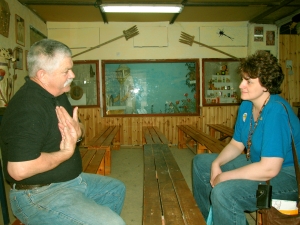 After that, we got to spend some time with Yigal, who runs the place. He has spent much of his life touring the world: he taught shepherding in Iran, and they taught him how to raise silkworms. He was stuck in NYC on 9/11, and is (understandably) reluctant to return to the states, even to see my roof bees. And one other thing: the universal rule that beekeepers will always find something about which to disagree (in this case, the likely role of hybridization on the temperament of Africanized honeybees) is absolutely intact!
After that, we got to spend some time with Yigal, who runs the place. He has spent much of his life touring the world: he taught shepherding in Iran, and they taught him how to raise silkworms. He was stuck in NYC on 9/11, and is (understandably) reluctant to return to the states, even to see my roof bees. And one other thing: the universal rule that beekeepers will always find something about which to disagree (in this case, the likely role of hybridization on the temperament of Africanized honeybees) is absolutely intact! So I was all abuzz, as they say, when we left and were driving through the gorgeous agricultural area of the Galilee. Yigal says that there are about 5,000 beekeepers in Israel, and that they are extremely important for much of the food produced there (think Jaffa oranges). I made Sam pull the car over (and drive it back about a kilometer) when we found this picture-perfect setting for honeybee pollination of a young fruit orchard.
So I was all abuzz, as they say, when we left and were driving through the gorgeous agricultural area of the Galilee. Yigal says that there are about 5,000 beekeepers in Israel, and that they are extremely important for much of the food produced there (think Jaffa oranges). I made Sam pull the car over (and drive it back about a kilometer) when we found this picture-perfect setting for honeybee pollination of a young fruit orchard.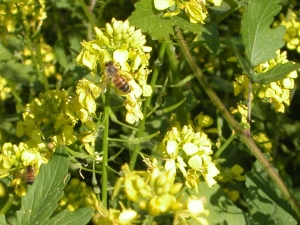 As I took the picture, however, I realized that the yellow flowers all around me were buzzing. These wildflowers, which I'll try to identify for you later, line almost every roadside. In fact, incredible wildflowers of many sorts (including, I think, papaver somniferum) are on roadsides, empty lots, and mountainsides all around the country just now. I laughed to think that the girls had been placed there to work the fruit trees, but were wallowing in the sun-baked wildflowers instead. It's Spring, it's beautiful, and I guess we are all on a vacation of sorts!
As I took the picture, however, I realized that the yellow flowers all around me were buzzing. These wildflowers, which I'll try to identify for you later, line almost every roadside. In fact, incredible wildflowers of many sorts (including, I think, papaver somniferum) are on roadsides, empty lots, and mountainsides all around the country just now. I laughed to think that the girls had been placed there to work the fruit trees, but were wallowing in the sun-baked wildflowers instead. It's Spring, it's beautiful, and I guess we are all on a vacation of sorts!